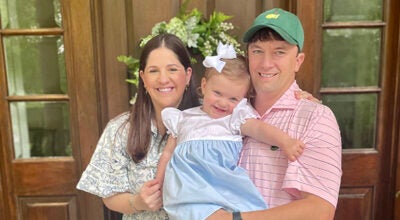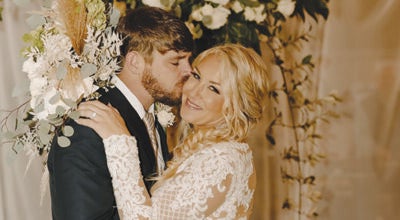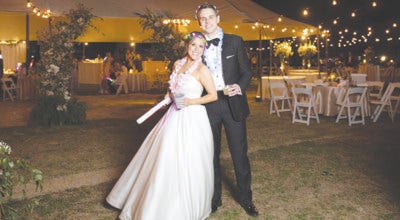Beekeeper Gregg Logan finds bees interesting and loves the hunt for swarms
Published 3:51 pm Friday, May 17, 2019

- Beekeeper Gregg Logan carries off a swarm he collected. (Walter Frazier | Vicksburg Living)
Honeybees are essential to our ecosystem. Without them, food production would not take place due to lack of pollination. /// So, while one may be fearful of a sting from these fuzzy black and yellow insects, it might be prudent to understand just how they function.
“Bees are fascinating creatures with complex social structures that are interesting to study,” beekeeper Gregg Logan said.
“The queen bee is literally the mother of all the bees in the hive,” Logan said, and her job starts within about six weeks from hatching.
As queen, she will direct the activities of the hive by mostly using pheromones, Logan said, which is the mechanism bees use to communicate.
“The queen communicates to the rest of the hive through these pheromones, which she can use to attract mates, suppress or induce swarming, signal her health and convey the condition of the hive,” he said.
Her job also includes laying eggs, the number of which will fluctuate depending on the time of year.
“In the fall the queen bee will reduce the number of eggs she lays,” Logan said, since plants will stop blooming in the winter.
But when the weather warms and the queen senses spring is near, he said, “She will pick up the pace of egg laying, so that the population of the hive will increase.”
Bees that perform all the work of the hive are called worker bees, Logan said, and these bees are comprised solely of female bees.
“From the moment they hatch they literally turn around and clean the cell from which they hatched, preparing it for the queen to lay another egg there,” he said.
In addition, Logan said, a worker bee serves in various roles that include house bee, nurse bee, guard bee, queen attendant and foraging bee.
The task of a drone bee is to mate with the queen and these, of course, are always males.
“But in late fall,” Logan said, these bees get the boot and are kicked out of the hive and left to starve, since they do no work and are only a drain on the honey stored in the hive.”
When masses of bees are seen grouped together, this is referred to as a bee swarm.
“A typical bee swarm contains a queen bee and several thousand worker bees,” Logan said. “They will leave their hive and settle in a ball of bees usually on a tree limb or a bush.”
A swarm will occur for a few different reasons, he said, one of which is their hive becomes overcrowded.
However, before a swarm can occur, the bees living in the hive will build three to six “queen” cells, Logan said, in an effort to produce a new queen bee.
“These special cells are larger than a normal honeycomb cell and are built for the sole purpose of pupating a larva into a queen bee rather than a worker bee,” he said.
While in this cell the female larva is fed a “royal jelly,” which Logan described as a highly nutritious secretion of the pharyngeal glands of a nurse bee.
Then, just prior to the cell hatching this new queen, the existing queen bee will stop laying eggs so her abdomen will shrink.
“This shrinkage returns her ability to fly,” he said, so she will then fly out of the hive taking half of the bees with her and creating a swarm.
If not disturbed, Logan said a swarm can stay in place for three to five days while scout bees search for a place to make a new hive.
Beekeepers can capture a swarm, Logan said, by carefully placing the swarm into a hive, then closing the entrance and taking it to one of his apiaries, or bee yard.
“I like to cut or bend the limb containing the swarm, placing them directly onto the top of the hive. I will then gently shake them into the hive or use a little smoke from my smoker to encourage them into the hive,” he said, adding, “If the hive is found acceptable then some of the bees will stick their tail in the air and fan their wings spreading the homing pheromone letting the other bees know that they have a new home.”
Logan said once most of the bees are in the hive, he places a top on it and moves the bees to one of his apiaries.
Although bees in a swarm are “generally very docile,” Logan said he typically wears a beekeeper suit to protect him from stings.
“Alarm pheromones are released when a bee stings,” Logan said, and when other bees pick up the alarm pheromone (which smells like a banana) they are likely to attack and sting as well.”
To take care of the bees, Logan, who along with his wife Teresa owns Breezy Hill Farms in Flora, said, he feeds them when their honey supply is low.
“We also treat to eliminate various pests from the hive and we provide a new queen if something untimely happens to the existing queen.”
Some beekeepers, he said, will plant nectar-rich flowers for their bees.
“Commercial beekeepers will also move their bees about to ensure pollination for farmers,” Logan said.
“I have read that one in three bites of food we consume are directly related to the pollination provided by bees and many food crops will not grow without efficient insect pollination,” Logan said, adding, “And, what would we do without the sweet, sweet honey that bees provide?”
Logan decided to become a beekeeper after learning about Colony Collapse Disorder (CCD).
“Across the U.S., bees have been suffering from CCD, which is an unexplained death of multiple bee colonies at an alarmingly high rate. Multiple university studies are yet to determine a single cause for CCD,” Logan said.
So, for those who are trying to eliminate a swarm, he suggests reaching out to a beekeeper and save them instead.
“If you have a swarm show up, contact your local beekeeper for removal rather than killing them,” he said.
Logan encouraged anyone who has an interest in beekeeping to reach out to their local beekeeping club for more information about becoming a hobby beekeeper.
“More people need to be involved in beekeeping to help ensure their survival,” he said.






